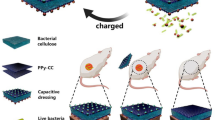Abstract
Percutaneous devices are extensively used in modern medicine therapies, even in long term applications. Complications from their use, related to bacterial colonization and/or to materials thrombogenicity, may result in a significant morbidity and mortality incidence. In this study, a novel polycarbonate-urethane (PCU), incorporating a tailor-made diamino-diamide-diol (PIME) showing the ability to bind heparin at physiological pH, was compared to commercial medical-grade PCUs (Carbothane® and Bionate®). Mechanical and thermal properties were evaluated by tensile tests, dynamic mechanical analysis and differential scanning calorimetry. The presence of a low amount of PIME chain extender in Bionate® polyurethanes (Bionate-PIME) slightly affects the mechanical properties, remaining however comparable with the medical grade PCUs used for the fabrication of cardiovascular devices. To verify thereof heparin surface adsorbed in disfavouring bacterial colonization, heparinized Bionate-PIME was tested for bacterial adhesion, using Bionate® and Carbothane® as reference. In vitro bacterial interaction tests were performed with the strains mainly involved in the pathogenesis of device-related infections (S. epidermidis and S. aureus). MTT tests and SEM observations showed a decrease in colonization of the different strains on the heparinized Bionate-PIME surfaces, confirming that preadsorbed heparin plays a role in mediating the biomaterial surface/bacterial cells interactions.





Similar content being viewed by others
References
P. N. DANESE, Chem. Biol. 9 (2002) 873
Y. H. AN and R. J. FRIEDMAN, J. Biomed. Mater. Res. (Appl. Biomater.) 43 (1998) 338
L. RIMONDINI, M. FINI and R. GIARDINO, J. Appl. Biomater. Biomech. 3 (2005) 1
D. W. SPELMAN, MJA 176 (2002) 286
P. EGGIMANN, H. SAX and D. PITTET, Microbes Infect. 6 (2004) 1033
M. K. SCHINABECK and M. A. GHANNOUM, Clin. Microbiol. Newsl. 25 (2003) 113
J. N. BAUMGARTNER and S. L. COOPER, J. Biomed. Mater. Res. 40 (1998) 660
P. FRANCOIS, P. VAUDAUX, N. NURDIN, H. J. MATHIEU, P. DESCOUTS and D. P. LEW, Biomaterials 17 (1996) 667
M. C. TANZI, S. FARÈ and P. PETRINI, J. Biomater. Appl. 14 (2000) 325
M. C. TANZI, Export Rev. Med. Devices 2 (2005) 473
B. D. Ratner and A. S. Hoffman, Biomaterials science: An introduction to materials in medicine (Elsevier Academic Press: San Diego, 2004) p. 197
U. MAKAL, L. WOOD, D. E. OHMAN and K. J. WYNNE, Biomaterials 27 (2006) 1316
P. PETRINI, M. C. TANZI, L. VISAI, F. CASOLINI and P. SPEZIALE, J. Biomater. Sci. Polym. Ed. 11 (2000) 353
R. S. WARD, K. R. MCCREA, Y. TIAN and M. C. TANZI, in Proceedings of the 7th world biomaterials congress, Sidney, May 2004 (Australian Society for Biomaterials Inc.: Victoria, 2004) p. 433
P. APPELGREN, U. RANSJÖ, L. BINDSLEV and O. LARM, Lancet 345 (1995) 130
L. RIMONDINI, S. FARÈ, E. BRAMBILLA, A. FELLONI, C. CONSONNI, F. BROSSA and A. CARASSI, J. Periodontol. 68 (1997) 556
L. VISAI, S. RINDI, P. SPEZIALE, P. PETRINI, S. FARÈ and M. C. TANZI, J. Biomater. Appl. 16 (2002) 191
G. LEWIS, C. S. J. van HOOY-CORSTJENS, A. BHATTARAM and L. H. KOOLE, J. Biomed. Mater. Res. (Appl. Biomater.) 73 (2005) 77
Acknowledgements
The Authors thanks Plan1Health (Amaro, Ud, I) for the financial support, PTG (Berkeley, CA, USA) for providing the materials, and GiMac (Castronno, Va, I) for the extrusion process.
Author information
Authors and Affiliations
Corresponding author
Rights and permissions
About this article
Cite this article
De Nardo, L., Farè, S., Di Matteo, V. et al. New heparinizable modified poly(carbonate urethane) surfaces diminishing bacterial colonization. J Mater Sci: Mater Med 18, 2109–2115 (2007). https://doi.org/10.1007/s10856-007-3083-9
Received:
Accepted:
Published:
Issue Date:
DOI: https://doi.org/10.1007/s10856-007-3083-9




